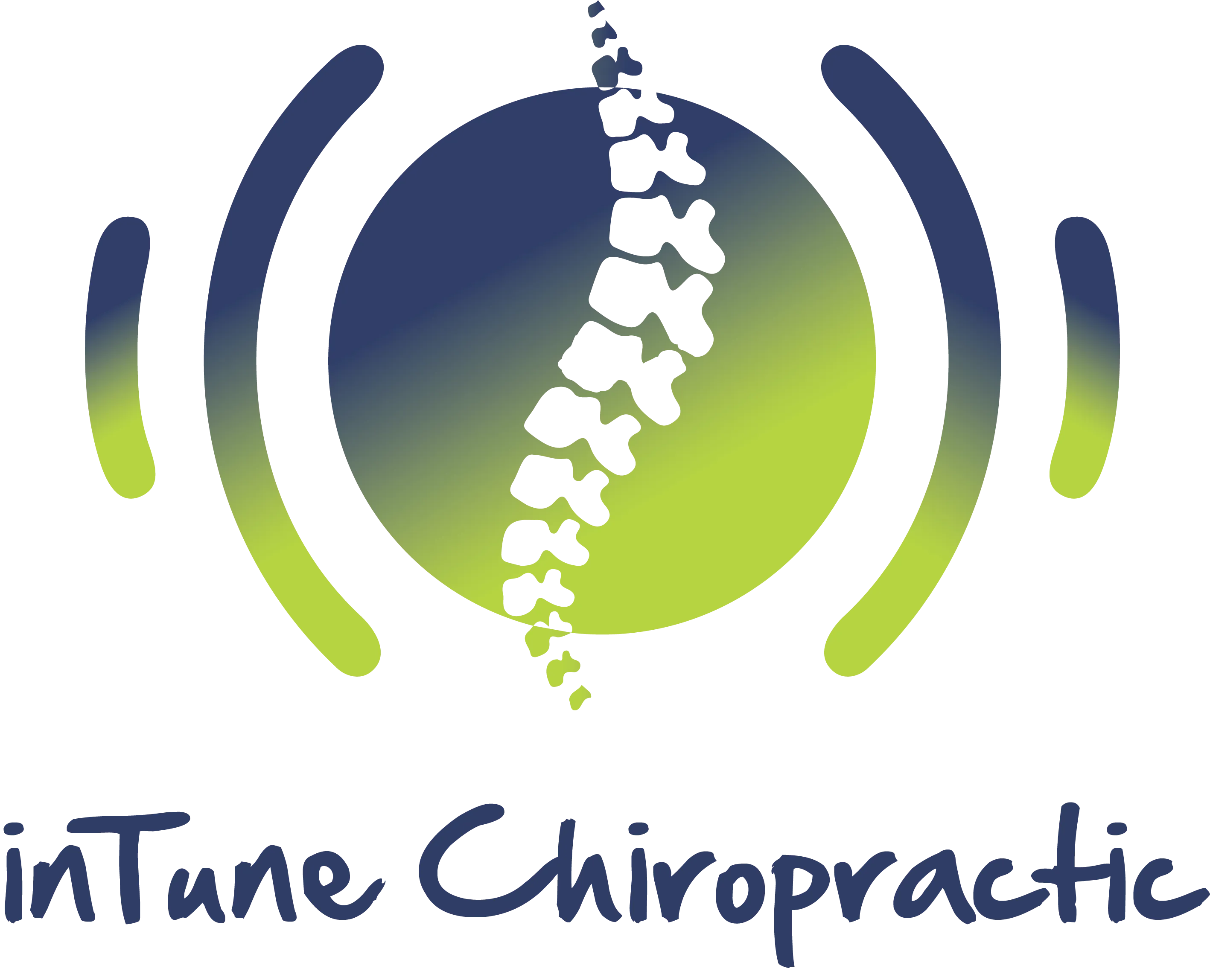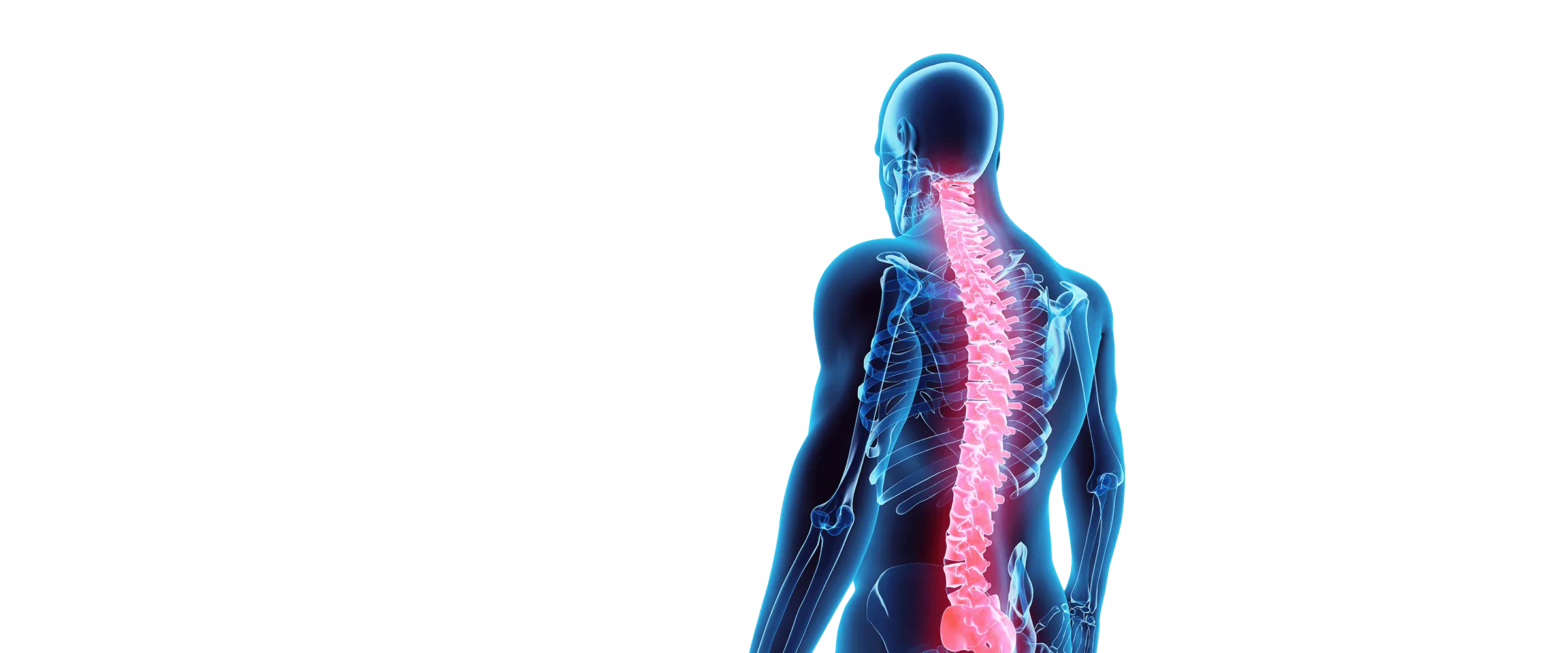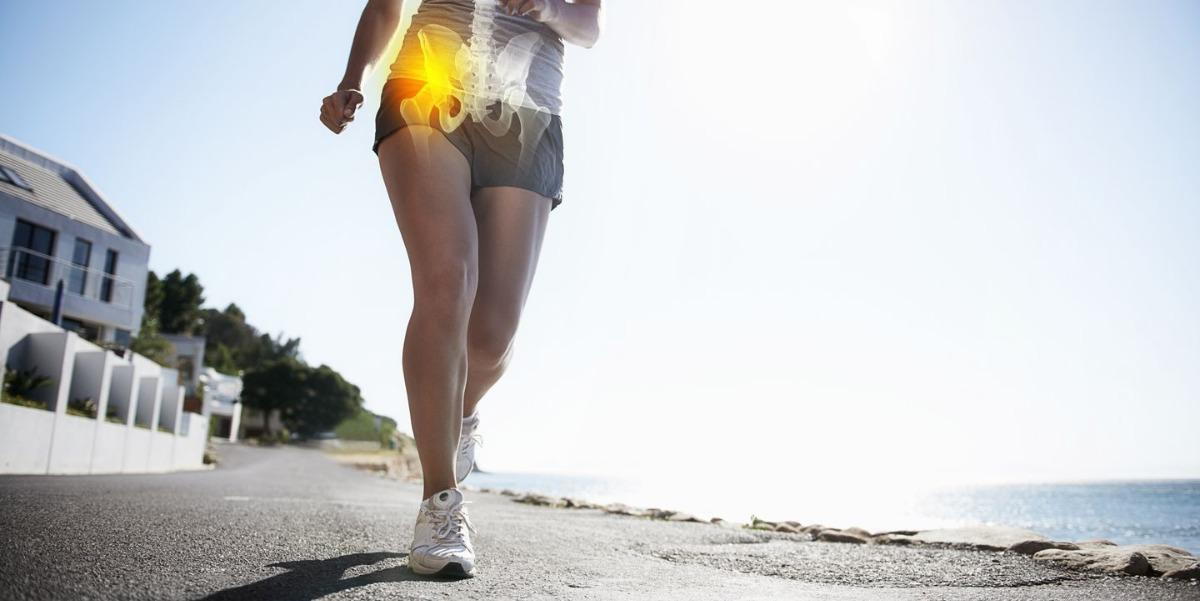
- posted: Aug. 10, 2020
Time and Time Again
Time and time again, especially with athletes, we will see patients coming into the office with excruciating low back pain. Time and time again they state how they have had trouble performing certain lifts in the gym, like squat or deadlifts, because they feel “locked up” or “too tight” to fully perform their lift. On the flip side of the coin we see tons of long-haul truck drivers coming in with the same presentations of issues as these athletes. What do these two completely separate groups have in common? Good question, the root to both of their issues usually results in the same conclusion …tight or weak hip flexor muscles!
I can promise you this, if you take one of those athletes and tell them to work a day as a long haul truck driver they will be complaining of the same kind of issues they see while performing their heavy lifts. As well as if we take the truck drivers and tell them to perform a good squat, they are going to be complaining of being “locked up” and unable to perform their lifts. This all boils down to having some sort of issue involving the patients hip flexor muscles.
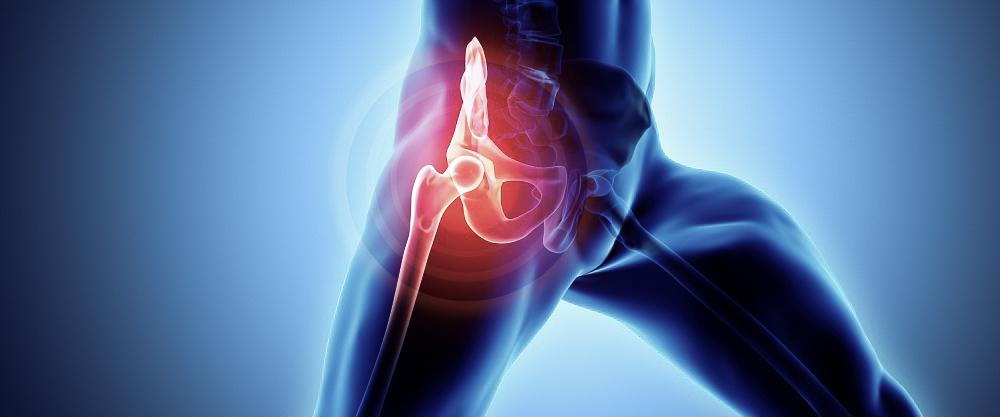 Truck Driver or Power Lifter, Your issue may be concerned with the hip flexor muscles!
Truck Driver or Power Lifter, Your issue may be concerned with the hip flexor muscles!
What are Hip Flexors?
The main purpose of your hip flexor muscles is bringing your knee to your chest and to aid in bending at the waist. Now think about that for a second…when truck drivers are on a long trip their in a sitting position with their hip in a 90 degree position, this causes a contraction of the hip flexor muscles and over long periods of time can cause fatigue of the muscle, sprains or strains to the muscle, or damage to the ligament/tendons of that muscle. Then if you think about that weightlifter performing squats, if the squats are not performed correctly with great form the repetitive contraction and extension of the hip flexor can lead to the same issues as stated above for the truck driver.
What muscles make up your hip flexor muscle group you ask? Well, first and foremost is the iliacus and psoas major muscles which come together and form your iliopsoas muscle. Secondly, your rectus femoris muscle which is part of your quadriceps muscle group. These all come together to help flex your hip…hence the name, hip flexor. A few different conditions that we see with the hip flexor muscle groups are strain/sprain, hip flexor tendinopathy, hip impingement, iliopsoas bursitis, hip labral tear, overuse syndrome, pelvic obliquity (tilted pelvis), Avascular necrosis (AVN), or osteoarthritis.
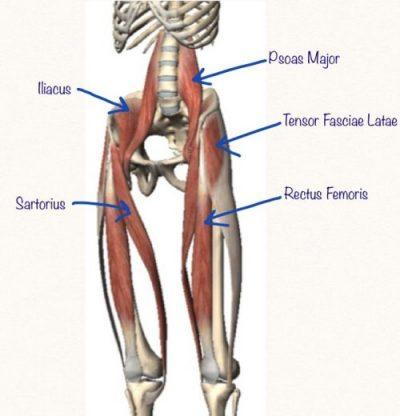 Hip Flexor Anatomy: The main hip flexor muscles consist of the Psoas Major, Iliacus, and Rectus femoris. But some other muscles that also aid in parts of the hip flexion movement are the Sartorious and TFL muscles!
Hip Flexor Anatomy: The main hip flexor muscles consist of the Psoas Major, Iliacus, and Rectus femoris. But some other muscles that also aid in parts of the hip flexion movement are the Sartorious and TFL muscles!
Hip Flexor Strain
The main issue we see in our office is a strain of the hip flexor muscles caused by an overuse of the muscle resulting in slight tearing of the associated tendons. When there is a strain to any muscle/tendon it is graded on a scale of I to III:
- Grade I: Minor tear, only a few fibers are damaged.
- Grade II: A significant number of the muscle fibers are damaged and there is a moderate to severe decrease in hip flexor mobility.
- Grade III: Muscle is completely ruptured or torn, and you cannot walk without a limp if you can even walk at all.
Luckily for you the most common of the three grades is a grade II strain. Also, good news is we can easily treat grade I and grade II strains in office with conservative Chiropractic care and soft tissue work. A grade II may take a little longer but at least you can avoid surgery, stay off drugs, and save TONS of money! Unfortunately, if you are presenting with a Grade III sprain, surgery may likely be your best option to avoid deformation of the muscles and ligaments and to fully allow the hip flexors to heal properly. But always remember the earlier you come to seek treatment the quicker the issue will heal.
So How Can Chiropractic Help?
First, we will conduct a thorough examination to see what exactly is occurring and indeed if this issue is a strain of the hip flexor muscles. Once we can pinpoint the problem area, we want to get motion back into the hips, pelvis, sacrum, and legs to take undue pressure off the strain in the hip flexor. When the surrounding skeletal system has restrictions in their associated joints it could lead to either more damage, decrease in function, and even osteoarthritis down the road.
We would start an adjusting protocol involving the hips, pelvis, and sacrum. The adjustments are then followed by passive soft tissue work, stretching, and other passive modalities. Exclusive to our office, inTune Chiropractic Clinic in Mount Juliet, TN is our Piezowave2 therapy which can non-invasively penetrate deep down into the tissue to kickstart the healing process and bring in more circulation to the problem area, which is desperately needed by the tendons and ligaments for healing. We will also prescribe you with some at-home exercises that you can begin doing to start stretching and strengthening the proper muscles to aid in the healing process.
Once we have a good start and there is a moderate decrease in pain, we will do a bunch of in-office exercises and stretches. This is helpful to get rid of the issue and make sure your body is fortified enough to make sure it does not happen again. Obviously, if this condition was caused by something you do everyday at work it is going to be a fight and you need to work with us and change some work routines and make sure to keep up with all the at-home exercises to stay as healthy as possible.
Hip Flexor Strain Stretches & Exercises
A few stretches that you can start immediately with a Grade I or Grade II strain to get your body back as quickly as possible are1:
- Hip Flexor Stretch: You need to kneel and then put one leg forward. Keep your foot flat on the floor. Flatten your lower back and lean your hips forward slightly until you feel a stretch at the front of your hip. Try to keep your body upright as you do this. Hold this position for 15 to 30 seconds. Repeat 3 times with each leg1.
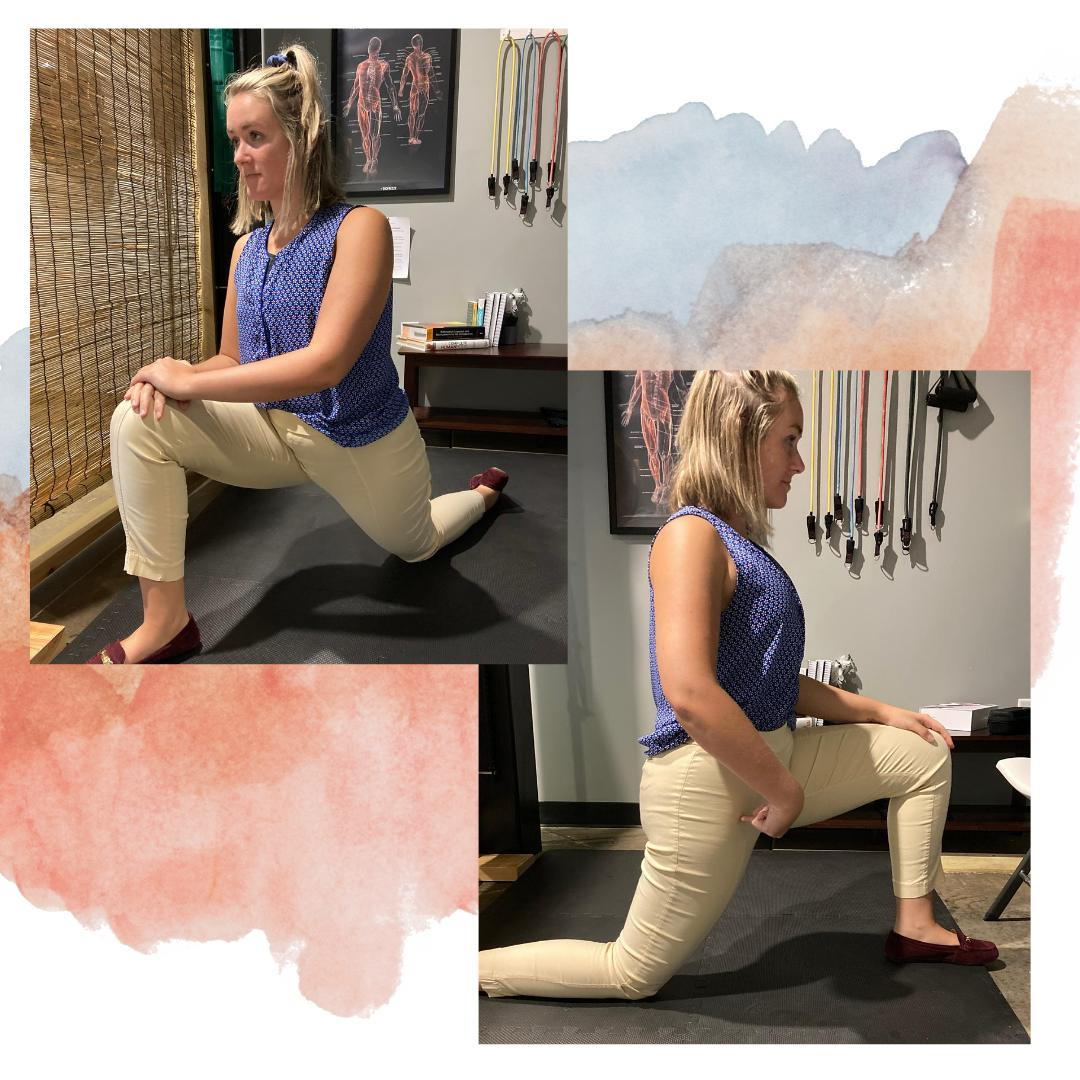 Dr. Chanel from inTune Chiropractic performing a basic hip flexor stretch. Variations of this stretch can also be performed to better stretch additional muscles/tendons/ligaments including the "achilles" tendon!
Dr. Chanel from inTune Chiropractic performing a basic hip flexor stretch. Variations of this stretch can also be performed to better stretch additional muscles/tendons/ligaments including the "achilles" tendon!
- Quadriceps Stretch: Stand at an arm's length away from the wall with your injured side farthest from the wall. Facing straight ahead, brace yourself by keeping one hand against the wall. With your other hand, grasp the ankle on your injured side and pull your heel toward your buttocks. Do not arch or twist your back or you may cause a completely different issue! Keep your knees together. Hold this stretch for 15 to 30 seconds1.
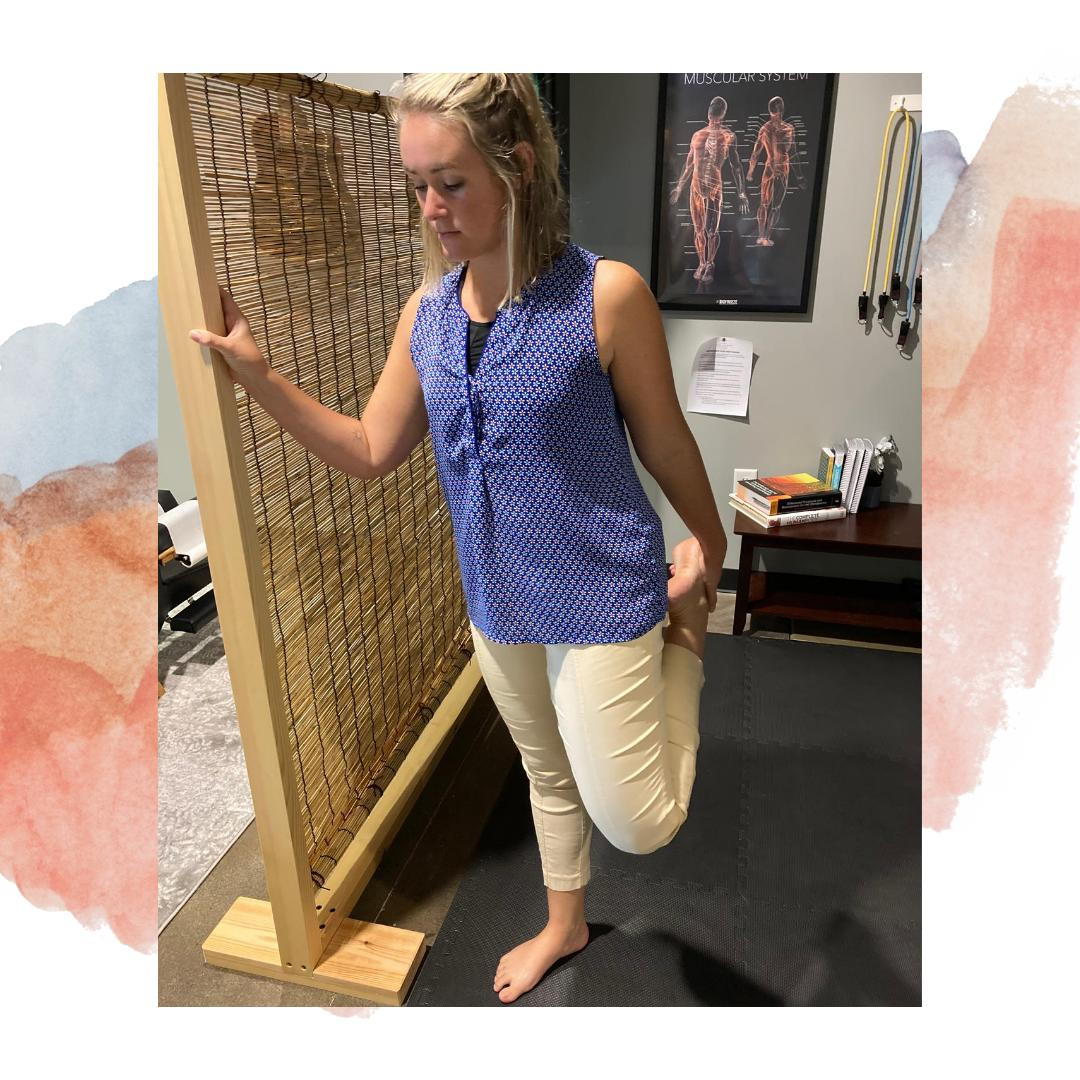 Dr. Chanel from inTune Chiropractic performing a basic quadriceps stretch focusing on the rectus femoris muscle. There can also be variations for this stretch to get an even deeper stretch!
Dr. Chanel from inTune Chiropractic performing a basic quadriceps stretch focusing on the rectus femoris muscle. There can also be variations for this stretch to get an even deeper stretch!
Once the healing process has started, the Chiropractic adjustments, soft tissue work and stretches restore function and motion back into the body and the hip flexors, there are a few more exercises that can be completed in order to ensure this issue will not return:
- Heel Slide: Sit on a firm surface with your legs straight in front of you. Slowly slide the heel of the foot on your injured side toward your buttock by pulling your knee toward your chest as you slide the heel. Return to the starting position. Do 2 sets of 151.
- Straight leg raise: Lie on your back with your legs straight out in front of you. Bend the knee on your uninjured side and place the foot flat on the floor. Tighten the thigh muscle on your injured side and lift your leg about 8 inches off the floor. Keep your leg straight and your thigh muscle tight. Slowly lower your leg back down to the floor. Do 2 sets of 151.
- Resisted Hip Flexion: Stand facing away from a door. Tie a loop in one end of a piece of elastic tubing and put it around the ankle on your injured side. Tie a knot in the other end of the tubing and shut the knot in the door near the floor. Tighten the front of your thigh muscle and bring the leg with the tubing forward, keeping your leg straight. Return to the starting position. Do 2 sets of 151.
Conclusion!
Do not let your pain or injury rule your life. We are here at inTune Chiropractic Clinic, Inc. to get you the help that you need. If this issue seems like it is something that you have been struggling with, then call and get in for a consultation we would love to help! inTune Chiropractic is your number 1 Mount Juliet and even Wilson County Chiropractor and we are here to treat the root cause of your problems and not just mask the symptoms. Our main goals are to get rid of the restrictions in your body in order to have your body naturally increase its function. I always like to say, “If you are 70 years old and cannot perform a body weight squat, you need to come in because your body isn’t functioning the way it should.” Do not let old age, injury, previous injury, or life get in the way of your body’s natural potential. Come on and schedule an appointment today, we cannot wait to get you back to doing the things you love!
Visit us at: inTune Chiropractic Website
Call and schedule at: 615.553.2268
Watch some more content on YouTube at: inTune Chiropractic YouTube Channel
Check out our other blogs updated weekly at: inTune Chiropractic Blog Content
References:
- Niemuth P, Johnson R, Myers M, Thieman T. Hip muscle weakness and overuse injuries in recreational runners. Clinical Journal Of Sport Medicine [serial online]. 2005;15(1):14-21. Available from: CINAHL with Full Text, Ipswich, MA. Accessed December 28, 2011.
